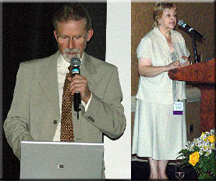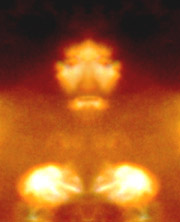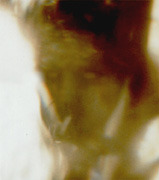
Diana and Alan speaking at the 2006 ATransC Conference.
Also, see
Diana and Alan Bennett- ITC and Diana and Alan Bennett – Crystal Imaging
©Diana and Alan Bennett – All Rights Reserved
We are pleased to be able to share with you some of our more recent work in the field of ITC imaging.
Since our Scole Group days, Diana and I have been continuing our work in trans-dimensional imaging. As some of you may know, this new work has taken us on quite a different path from those interesting experiments back in ‘96 – ‘97. In those days we relied entirely on ‘spirit’ communication for direction, now it is a combination of communication and (more recently) allowing our ‘higher minds’ to guide us.
We have felt for some time that the chances of getting good results are greatly improved if we offer as many variables as possible within the experimental framework. By this we mean, thinking of the experiments themselves as multi-dimensional and not just a singular attempt to get a singular result. We firmly believe that by supplying a randomized source of material for the ‘other side’ to use, we (and they) stand a far greater chance of success. Having found a working ‘formula’, we then attempt to get repeatable results until inspired to change direction.
Faces seem to be the most common results up to this time. From the many images we have, around 90% are faces, or parts of faces. Sometimes the images are very small, so we cannot overemphasize the importance of studying in detail when checking the results.
Our current experiments mainly take the form of a joint meditative session, where we raise our consciousness and focus together on our objective for that experiment. The equipment is pre-configured and ready to run, allowing us to focus on providing the best energy conditions. We usually have several ‘takes’ during a typical session, again leaving it to what feels right.
Refraction and Reflection

We have used mirrors in a variety of ways. For example, to reflect a light source back into the point of focus (where we capture the images), to give the subject depth. Have you ever looked through a simple microscope and seen how adjusting the mirror (light source) gives the object greater depth and makes it stand out against its background? This is similar to what the camera sees during our experiments.
Within our light experiments, we generate a vast spectrum of color and light intensities. Some of the light frequencies generated are of course beyond our own visible spectrum, so the resulting light contains much more information than we realize.
We may include a mirror between the source and the subject or even beyond the focal point, allowing the light to flood back onto the subject. Apart from ordinary mirrors, we have used convex and concave types to very good effect. We have also experimented with polished metallic disks such as brass (yellow) and copper (red), which have created some of the more striking images.
Clarity

We are now experimenting with other cameras and video, trying to increase the clarity of the images. Without getting too technical, it is the resolution of the captured image that governs the quality. If you haven’t captured a particularly clear image to start with, enlarging it (often necessary) only makes it worse not better. We have found that most video cameras ‘off the shelf’ offer a far too low resolution for what we need. Having said that, they certainly have their place and do allow us to capture a ‘stream’ of frames all in one go. As a point of interest, we have captured at 25 frames per second but get better results at 10 fps. The reasoning behind this, again, is image (frame) quality. We also capture as a stream of individual bitmaps and not frames (more on this perhaps another time).
Another factor that governs resolution and image quality is transferring your images into your computer. This requires imaging software and a ‘Capture card’ to be installed. We have found that some of these capture devices can be insufficient in their capture capabilities, so it’s money well spent when buying the best you can.
Some of our best images have been obtained using ordinary photographic film. The results, whether transparencies or not, can be magnified many times without losing quality, allowing for a very fine image definition. This is due to fact we’re working with the ‘grain’ of a film and not ‘pixels’ as in digital photography. In an ideal world we need the best of both systems, and it is to this end that we are now working toward with new equipment.
![]()
